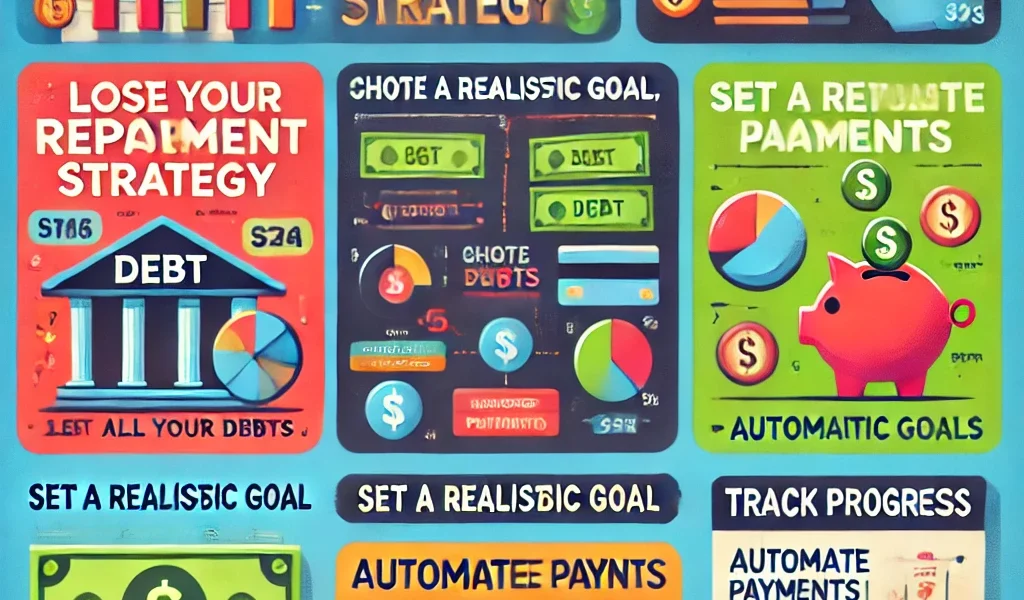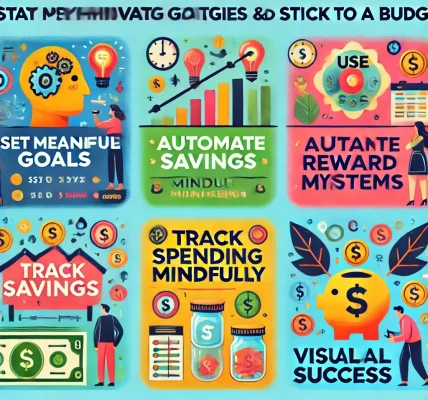📚 Introduction:
Debt can feel overwhelming and burdensome, especially when payments accumulate over time. Whether it’s credit card debt, student loans, personal loans, or medical bills, managing multiple payments can put a strain on your monthly budget. Without a structured repayment plan, high-interest debts can quickly spiral out of control, affecting both your financial stability and credit score.
If you’re looking to pay off your debt faster while staying within a realistic budget, this guide is for you. We will explore proven strategies to create an effective budget, prioritize debt payments, and free yourself from financial stress sooner.
🎯 Why Budgeting is Key to Paying Off Debt Faster
A well-structured budget acts as a roadmap for debt repayment by ensuring that you allocate funds strategically and consistently. Without budgeting, it’s easy to lose track of payments and continue accumulating interest.
✅ Benefits of Budgeting for Debt Repayment:
- Helps prioritize debt over non-essential expenses.
- Reduces interest payments by accelerating repayment.
- Prevents late payments and improves your credit score.
- Allows you to track progress and stay motivated.
📊 Understanding Your Debt Situation
Before creating a budget to accelerate debt repayment, it’s important to have a clear understanding of your debt obligations.
📝 1. List All Your Debts
Start by making a list of all your outstanding debts, including:
✅ Details to Include:
- Name of the creditor.
- Total balance owed.
- Minimum monthly payment.
- Interest rate (APR).
- Due dates for each payment.
🚨 Pro Tip:
Use a spreadsheet or budgeting app to keep track of your debts and update them regularly.
📝 2. Determine Your Total Debt Load
Add up the total amount of debt you owe to get a clear picture of your overall financial obligation.
✅ Key Metric:
- Debt-to-Income Ratio (DTI) = (Total Monthly Debt Payments ÷ Monthly Income) × 100
🚨 Pro Tip:
Aim to keep your DTI ratio below 36% to maintain financial stability.
📝 3. Identify High-Interest Debts
Prioritize high-interest debts, such as credit card balances, as these can grow rapidly over time.
✅ Examples of High-Interest Debts:
- Credit card debt (15%–25% APR)
- Payday loans (up to 400% APR)
🚨 Pro Tip:
Targeting high-interest debts first reduces the overall amount paid in interest.
📈 Step-by-Step Guide to Create a Budget to Pay Off Debt Faster
📝 Step 1: Analyze Your Income and Expenses
Track your income and all your monthly expenses to understand how much money is coming in and going out.
✅ Key Elements to Consider:
- Fixed expenses: Rent, mortgage, utilities, insurance.
- Variable expenses: Groceries, dining out, entertainment.
- Discretionary spending: Shopping, travel, subscriptions.
🚨 Pro Tip:
Use apps like Mint or YNAB (You Need a Budget) to categorize and monitor your spending.
📝 Step 2: Set a Realistic Debt Repayment Goal
Establish a clear and achievable goal for how quickly you want to pay off your debt.
✅ Examples:
- Pay off credit card debt in 12 months.
- Eliminate student loan debt in 24 months.
🚨 Pro Tip:
Set SMART (Specific, Measurable, Achievable, Relevant, Time-Bound) goals to stay motivated.
📝 Step 3: Choose a Proven Debt Repayment Strategy
When it comes to paying off debt, there are two widely used and effective methods:
🎯 1. Debt Snowball Method
In the debt snowball method, you focus on paying off your smallest debt first while making minimum payments on other debts. Once the smallest debt is paid off, you move to the next smallest.
✅ How It Works:
- List debts from smallest to largest.
- Pay extra toward the smallest debt.
- Roll over the payment amount to the next debt.
🚨 Pro Tip:
This method provides psychological motivation by giving you small wins.
🎯 2. Debt Avalanche Method
The debt avalanche method prioritizes paying off high-interest debts first to minimize interest payments over time.
✅ How It Works:
- List debts from highest to lowest interest rates.
- Pay extra toward the highest-interest debt.
- Move to the next highest-interest debt.
🚨 Pro Tip:
This method is more cost-effective as it reduces overall interest payments.
📝 Step 4: Allocate Extra Payments in Your Budget
Identify areas in your budget where you can cut back to free up extra cash for debt payments.
✅ Ways to Free Up Extra Money:
- Reduce dining out and entertainment expenses.
- Cancel unused subscriptions.
- Lower utility bills by conserving energy.
🚨 Pro Tip:
Apply any windfalls, such as tax refunds or bonuses, toward debt repayment.
📝 Step 5: Automate Your Debt Payments
Set up automatic payments to ensure you never miss a due date, preventing late fees and additional interest charges.
✅ Benefits of Automation:
- Ensures timely payments.
- Reduces the risk of missed payments.
- Keeps your repayment plan on track.
🚨 Pro Tip:
Automate extra payments toward high-interest debts.
📝 Step 6: Build an Emergency Fund to Avoid New Debt
An emergency fund protects you from unexpected expenses and prevents you from relying on credit in times of crisis.
✅ How to Build an Emergency Fund:
- Start by saving at least ₹20,000 or one month’s worth of expenses.
- Gradually increase the fund to cover 3-6 months of living expenses.
🚨 Pro Tip:
Keep your emergency fund in a high-yield savings account.
💡 How to Stick to Your Debt Repayment Budget
🎯 1. Track Your Progress Regularly
Monitor your debt payoff progress every month and celebrate small wins along the way.
🎯 2. Adjust Your Budget as Needed
If your income or expenses change, revisit your budget and make necessary adjustments.
🎯 3. Stay Motivated with Visual Reminders
Create a debt payoff chart or use an app to visualize your journey toward becoming debt-free.
🎯 4. Avoid Accumulating New Debt
Resist the temptation to take on new debt while repaying existing obligations.
🛑 Common Mistakes to Avoid While Paying Off Debt
- Paying Only Minimum Payments:
Minimum payments prolong debt repayment and increase interest costs. - Ignoring High-Interest Debts:
Focusing on smaller debts while ignoring high-interest debts can cost you more in the long run. - Not Building an Emergency Fund:
Without an emergency fund, unexpected expenses can derail your repayment plan. - Overestimating Your Ability to Make Extra Payments:
Be realistic about how much extra you can allocate toward debt. - Falling Back into Old Spending Habits:
Stick to a frugal lifestyle even after becoming debt-free.
📈 Advanced Tips to Pay Off Debt Even Faster
💡 1. Consolidate Debt for Lower Interest Rates
Consider consolidating high-interest debts into a single loan with a lower interest rate.
💡 2. Negotiate Lower Interest Rates with Creditors
Call your creditors and negotiate for a lower interest rate to reduce the overall cost of debt.
💡 3. Use Windfalls and Bonuses Wisely
Apply any unexpected income, such as bonuses or tax refunds, toward debt repayment.
💡 4. Increase Your Income with Side Hustles
Explore side gigs or freelance work to earn extra income and accelerate debt repayment.
🎉 Conclusion: Take Control of Your Debt with a Strategic Budget
Creating a budget to pay off debt faster requires discipline, consistency, and a clear strategy. By analyzing your debt, choosing a repayment method, and allocating extra payments toward high-interest debts, you can accelerate your journey to becoming debt-free.
Following these proven strategies will not only help you eliminate debt but also build a stronger financial future, giving you peace of mind and financial freedom.




